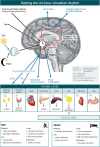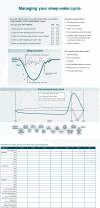Manipulating the sleep-wake cycle and circadian rhythms to improve clinical management of major depression
- PMID: 23521808
- PMCID: PMC3760618
- DOI: 10.1186/1741-7015-11-79
Manipulating the sleep-wake cycle and circadian rhythms to improve clinical management of major depression
Abstract
Background: Clinical psychiatry has always been limited by the lack of objective tests to substantiate diagnoses and a lack of specific treatments that target underlying pathophysiology. One area in which these twin failures has been most frustrating is major depression. Due to very considerable progress in the basic and clinical neurosciences of sleep-wake cycles and underlying circadian systems this situation is now rapidly changing.
Discussion: The development of specific behavioral or pharmacological strategies that target these basic regulatory systems is driving renewed clinical interest. Here, we explore the extent to which objective tests of sleep-wake cycles and circadian function - namely, those that measure timing or synchrony of circadian-dependent physiology as well as daytime activity and nighttime sleep patterns - can be used to identify a sub-class of patients with major depression who have disturbed circadian profiles.
Summary: Once this unique pathophysiology is characterized, a highly personalized treatment plan can be proposed and monitored. New treatments will now be designed and old treatments re-evaluated on the basis of their effects on objective measures of sleep-wake cycles, circadian rhythms and related metabolic systems.
Figures




References
-
- Horowitz AV, Wakefield JC. The Loss of Sadness: How Psychiatry Transformed Normal Sorrow into Depressive Disorder. New York: Oxford University Press; 2007. - PubMed
-
- Shorter E. Before Prozac: The Troubled History of Mood Disorders in Psychiatry. New York: Oxford University Press; 2009.
-
- DSM-5: the future of psychiatric diagnosis. http://www.dsm5.org/Pages/Default.aspx.
-
- Diagnosing the D.S.M. http://www.nytimes.com/2012/05/12/opinion/break-up-the-psychiatric-monop....
-
- Psychiatry’s bible, the DSM, is doing more harm than good. http://articles.washingtonpost.com/2012-04-27/opinions/35450916_1_bipola....
Publication types
MeSH terms
LinkOut - more resources
Full Text Sources
Other Literature Sources
Medical

